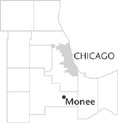| Entries |
| M |
|
Monee, IL
|
 Will County, 32 miles S of the Loop. Strong local tradition ties the name of the village to the
Ottawa
wife of Joseph Aubert de Gaspe Bailly. Marie and Joseph Bailly operated a
fur trading
post now within the grounds of the
Indiana Dunes
National Lakeshore in
Chesterton,
Indiana. Because of language difficulties, Marie was often referred to as “Mo-Nee” rather than “Ma-Rie.”
Treaties
in 1832 apportioned land to “the five daughters of Mo-nee, by her last husband, Joseph Bailly,” including Raccoon Grove south of the present-day village. Settlers came in the mid-1830s to the edges of Raccoon Grove, farming the high ground of the Valparaiso Moraine.
Will County, 32 miles S of the Loop. Strong local tradition ties the name of the village to the
Ottawa
wife of Joseph Aubert de Gaspe Bailly. Marie and Joseph Bailly operated a
fur trading
post now within the grounds of the
Indiana Dunes
National Lakeshore in
Chesterton,
Indiana. Because of language difficulties, Marie was often referred to as “Mo-Nee” rather than “Ma-Rie.”
Treaties
in 1832 apportioned land to “the five daughters of Mo-nee, by her last husband, Joseph Bailly,” including Raccoon Grove south of the present-day village. Settlers came in the mid-1830s to the edges of Raccoon Grove, farming the high ground of the Valparaiso Moraine.
In 1853 the Illinois Central Railroad established a station at Monee. The town soon boasted a general store, a schoolhouse, and a grain warehouse with several elevators. By the 1870s, there were several small farm implements factories, four churches, and a massive wind gristmill.
Boosters hoped that Monee, midway between Chicago and Kankakee, would become a major city. Residents voted to incorporate as the village of Monee in 1874. In 1872 a German Baptist School Academy opened in a former brewery but survived only four years.
The Illinois Central depot was complemented in 1907 by a stop on the interurban line from Chicago to Kankakee. Monee also had a picnic ground and amusement park at Raccoon Grove.
The small town center developed with the Illinois Central line at ground level. However, to lower the tracks, the railroads cut through the center of Monee in 1922, dramatically affecting train traffic that had previously gone uphill from both Chicago and Kankakee. The Illinois Central built a new depot down in the cut and four bridges were built to provide access around the community.
With an interchange on I-57, Monee has continued to grow as part of the southern expansion of the metropolitan region.
| Monee, IL (inc. 1874) | |||||
| Year |
Total
(and by category) |
Foreign Born | Native with foreign parentage | Males per 100 females | |
| 1870 | 598 | 44.5% | — | — | |
| 1900 | 462 | — | — | — | |
| 1930 | 383 | — | — | — | |
| 1960 | 646 | — | — | — | |
| 1990 | 1,044 | 3.4% | — | 110 | |
| 1,042 | White (99.8%) | ||||
| 2 | Other race (0.2%) | ||||
| 27 | Hispanic Origin* (2.6%) | ||||
| 2000 | 2,924 | 1.7% | — | 101 | |
| 2,745 | White alone (93.9%) | ||||
| 62 | Black or African American alone (2.1%) | ||||
| 2 | American Indian and Alaska Native alone (0.1%) | ||||
| 13 | Asian alone (0.4%) | ||||
| 55 | Some other race alone (1.9%) | ||||
| 47 | Two or more races (1.6%) | ||||
| 118 | Hispanic or Latino* (4.0%) | ||||
The Encyclopedia of Chicago © 2004 The Newberry Library. All Rights Reserved. Portions are copyrighted by other institutions and individuals. Additional information on copyright and permissions.